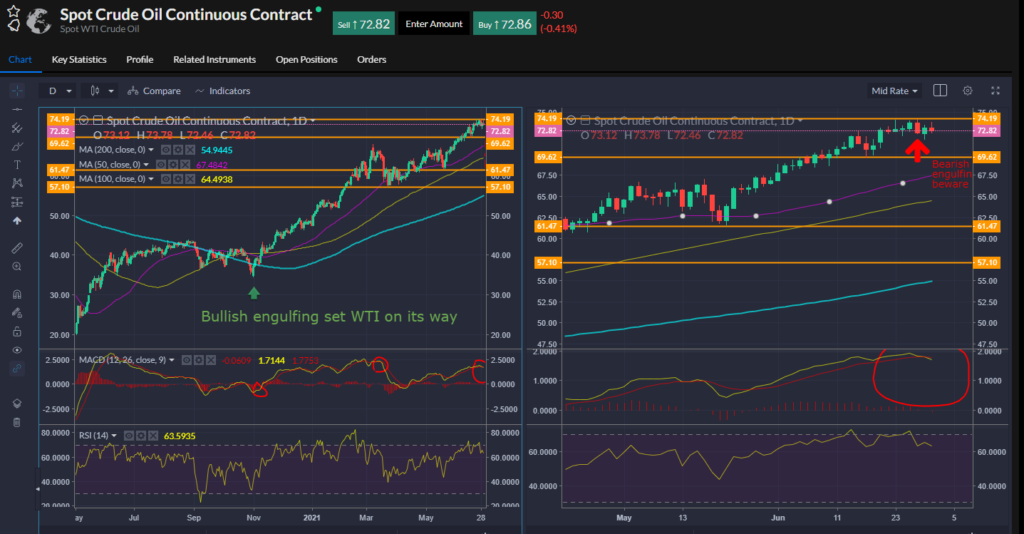
Wednesday Jun 30 2021 15:35

5 min
The Organisation of Petroleum Exporting Countries and its allies (OPEC+) convene on Thursday, July 1st to discuss the next phase of production constraints. The cartel is already increasing output by 2.1m bpd from May through to July and has successfully carried off this increase whilst still presiding over rising prices. The focus on the meeting is whether to maintain this gradual easing of production curbs in August and potentially beyond. Market expectations suggest OPEC+ will increase output by around 500k bpd in August but there are still plenty of unknowns.
On Wednesday, OPEC secretary general maintained a bullish outlook for oil demand recovery this year but pointed to risks on the horizon. He said that while OECD oil stocks are now below the 2015-2019 average, significant uncertainty in oil markets calls for prudence, highlighting the considerable risk to demand outlook from Covid variants.
Demand recovery is uncertain. Whilst US air travel passenger numbers are almost back to 2019 levels, and German diesel demand has recovered to pre-pandemic levels, there are clearly risks that the spread of variants like Delta around the globe will constrain or delay the pick-up in demand that has generally been expected to take place this year. Delta keeps OPEC mindful of being too loose and suggests it might err on the side of less production for the time being – particularly as so much of this year’s demand is seen returning in the second half (see below).
E.g., Japanese oil demand is still pretty soft with consumption in May down 8.5% vs 2019. It highlights that outside of China, a combination of relatively low vaccination rates and the Delta variant continue to weigh on local crude demand.
Nevertheless, OPEC is unlikely to have to contend with a surge of Iranian oil imports onto the market as progress on the nuclear deal to lift sanctions is slow, with talks delayed, and may never happen. Meanwhile US production has not recovered as quickly as one might have thought – the rig count is higher at 470 but well below the ~800 before the pandemic.
Barkindo said global oil demand should rise 6m bpd in 2021, with 5bpd of that figure due to arrive in H2. This presents a risk that oil demand recovery is weighted to the second half of the year and may not emerge due to new restrictions on mobility in response to new waves of the virus. This could leave OPEC+ unwilling to ease of restraints as much as the market thinks it will. On the other hand, there is evidence the market is increasingly tight and OPEC may prefer to ease off a touch to loosen it. Goldman Sachs reckons global demand will rise by an additional 2.2m bpd by the end of 2021, which would leave a 5m bpd supply shortfall. “Ultimately, much more OPEC+ supply will be needed to balance the oil market by 2022,” the bank said in a note.
An internal OPEC report seen by Reuters indicates the cartel is worried the market will return to surplus after the self-imposed output curbs end in April 2022. This could lead to discussion about extending supply cuts beyond that date. An extension would pick up the back end of the curve, which is looking a bit tired, and net would be considered bullish for prices, but could be offset by a larger-than-expected increase in the near-term to compensate some members.
Prices have rallied strongly this year, but members of the cartel need even higher crude prices. The OPEC average fiscal breakeven oil prices stand at $93, according to RBC, which thinks OPEC+ could add anything from 500k bpd to 1m bpd in August.
Ahead of the meeting, the latest EIA report today shows a continued draw on inventories. Stockpiles declined by 6.7m barrels, vs the estimated draw of 3.8m, supported by a net 500k bpd decline in imports and a 200k bpd increase in refinery demand. Total products supplied over the last four-week period averaged 20.0 million barrels a day, up by 13.3% from the same period last year.
US commercial crude oil inventories decreased by 6.7 million barrels in the week to Jun 25th from the previous week, yet another weekly draw that leaves inventories at their lowest since March 2020. At 452.3 million barrels, inventories are about 6% below the five-year average for this time of year. Total motor gasoline inventories increased by 1.5 million barrels, whilst distillates fell by 900k.
Post the EIA report it’s pretty much as you were with all eyes on OPEC+. As we flagged in Tuesday’s morning note, there is something of a technical hitch for oil. So far this market has been a buy-the-dip affair as WTI edged up above $74 this week to its highest in almost three years, moving close to a 6-year high in the mid-70s; and market fundamentals are solid as supply remains tight. But Monday’s outside day bearish engulfing candle is a potential red flag, while the bearish MACD crossover on the daily chart is another. RSI bearish divergence is a third with a higher high on the price met by a lower high on the 14-day RSI, indicating buyer exhaustion. This is not necessarily the top but would call for a potential near-term pullback such as a ~10% correction as seen in Mar/Apr this year.
500k bpd is the baseline – go beyond that to 750k, 1m then it’s a bearish reaction in the market. Go under and it’s bullish. But these would be only the immediate responses and market fundamentals remain positive even with more crude coming on stream. Technicals are less inclined to support the bullish outlook in the immediate near-term sense. A temporary pullback would allow for the bulls to take a breath before resuming the uptrend.

